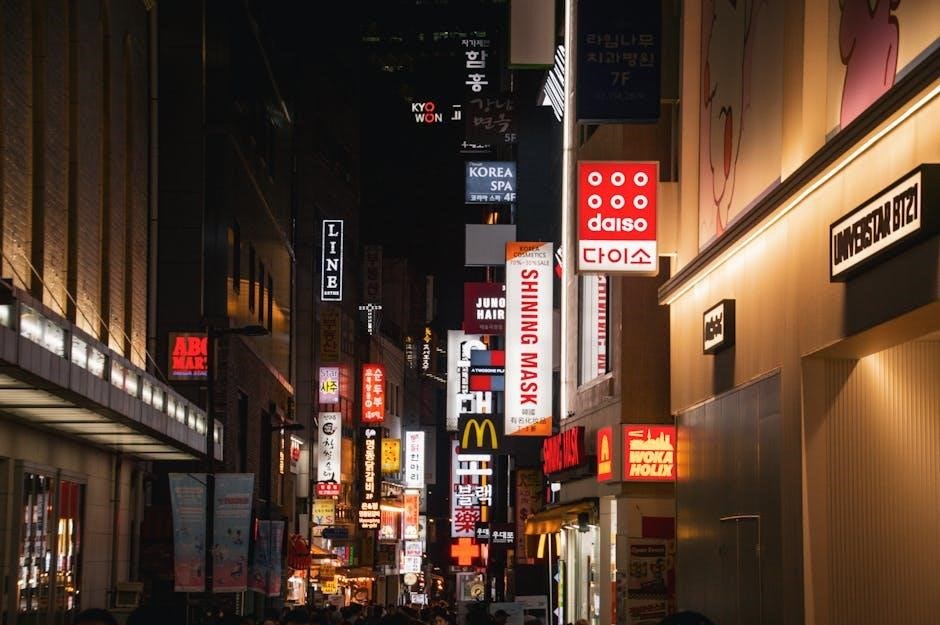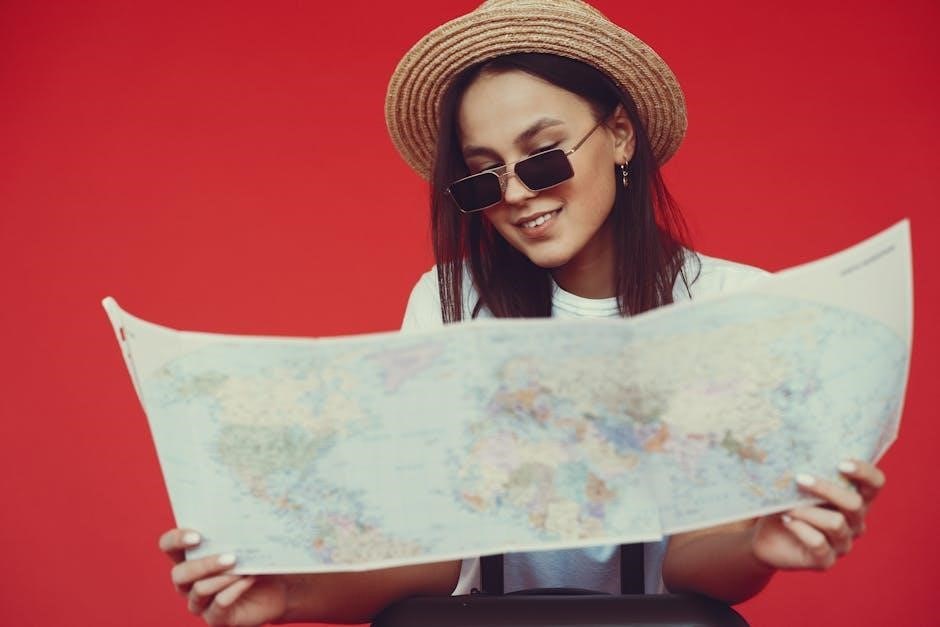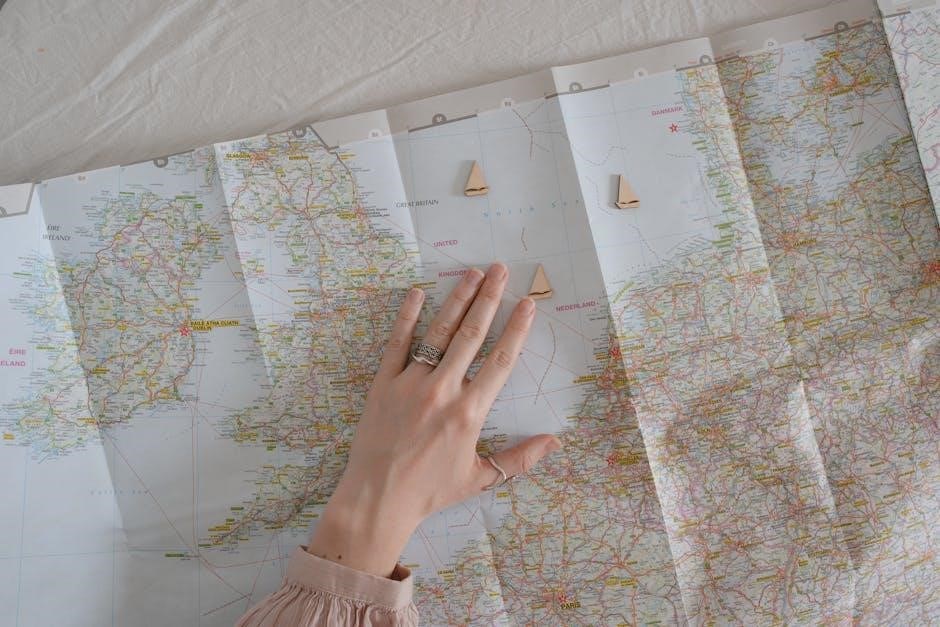South Korea, a vibrant blend of tradition and modernity, offers rich cultural experiences, breathtaking landscapes, and dynamic cities. From bustling Seoul to serene Jeju Island, it captivates travelers with its unique charm, K-pop culture, and welcoming locals.
Overview of South Korea
South Korea, officially the Republic of Korea, is a dynamic country blending rich heritage with modern innovation. Known for its vibrant cities, stunning landscapes, and warm hospitality, it offers a unique cultural experience. From bustling Seoul to scenic Jeju Island, the country captivates travelers with its K-pop culture, historical sites, and delicious cuisine.
South Korea’s diverse attractions include bustling metropolises, serene natural beauty, and a lively arts scene. Its people, traditions, and cuisine reflect a harmonious mix of past and present, making it a must-visit destination for global travelers seeking unforgettable experiences.
Geography and Climate
South Korea is a peninsula bordered by the Pacific Ocean to the east, the Yellow Sea to the west, and the Korea Strait to the south. Its diverse landscape features rugged mountains, scenic coastlines, and fertile plains. The Taebaek Mountains form the backbone of the peninsula, while lowlands and islands dot the coastline.
The climate varies seasonally, with hot, humid summers and cold, snowy winters. Spring and autumn bring mild temperatures, making them ideal for exploration. This geographical diversity creates a rich natural environment, from lush forests to dramatic shorelines, enhancing South Korea’s allure as a travel destination.

When to Visit South Korea
South Korea offers ideal travel conditions during spring and autumn, with mild weather and vibrant festivals, making these seasons the peak times for exploration.
Best Time to Travel
The best time to visit South Korea is during spring (March to May) and autumn (September to November), when temperatures are mild and festivals abound. Spring offers cherry blossoms and vibrant culture, while autumn boasts stunning foliage. Summer can be hot and humid, ideal for beach destinations like Busan and Jeju Island. Winters are cold but perfect for skiing and enjoying hot springs. Plan your trip according to your preferences for weather and activities to make the most of your South Korean adventure.
Seasonal Highlights and Festivals
South Korea’s vibrant festivals and seasonal highlights offer unforgettable experiences. Spring brings the stunning cherry blossoms and the Lotus Lantern Festival, celebrating Buddha’s birthday. Summer features lively events like the Boryeong Mud Festival. Autumn showcases the Seoul Lantern Festival along Cheonggyecheon Stream and the Jinju Lantern Festival, while the changing foliage creates breathtaking landscapes. Winter delights with skiing in PyeongChang and the festive atmosphere of Seoul’s winter illuminations. Each season offers unique cultural and natural beauty, making every visit a memorable adventure;

Main Destinations in South Korea
Discover South Korea’s vibrant cities, stunning landscapes, and rich heritage. Explore Seoul’s bustling streets, Busan’s beaches, Jeju’s natural beauty, and historic cultural sites.
Seoul: The Capital City
Seoul, the heart of South Korea, is a dynamic city blending tradition and modernity. Explore iconic landmarks like Gyeongbokgung Palace and Bukchon Hanok Village. Discover vibrant shopping districts such as Myeongdong and Dongdaemun. Enjoy breathtaking views from Namsan Seoul Tower and indulge in street food at bustling markets. The city’s rich cultural heritage, coupled with its cutting-edge innovation, makes it a must-visit destination for any traveler.
- Must-see landmarks: Gyeongbokgung Palace, Bukchon Hanok Village.
- Vibrant shopping: Myeongdong, Dongdaemun, and COEX Mall.
- Cultural experiences: Traditional tea houses, K-pop performances, and festivals.
Busan: The Beachside Metropolis
Busan, South Korea’s second-largest city, is a coastal gem known for its stunning beaches, vibrant markets, and rich cultural heritage. Visit Haeundae Beach for its crystal-clear waters and bustling atmosphere. Explore the serene Beomeosa Temple, nestled in the mountains, and discover the lively Gukje Market for local delicacies and souvenirs. The city’s unique blend of relaxation and urban energy makes it a prime destination for both beach lovers and culture enthusiasts.
- Top attractions: Haeundae Beach, Beomeosa Temple.
- Must-visit markets: Gukje Market, Jagalchi Fish Market.
Jeju Island: Natural Wonder
Jeju Island, a UNESCO World Heritage Site, captivates visitors with its stunning natural beauty. Known as the “Hawaii of Korea,” it features towering volcanic landscapes, cascading waterfalls, and pristine beaches. Hallasan Mountain, the highest peak in South Korea, offers breathtaking hiking trails, while Seongsan Ilchulbong Sunrise Peak is a must-visit for its unique crater formation. The island’s lush green countryside and romantic ambiance make it a perfect getaway for nature lovers and honeymooners alike.
- Must-see attractions: Hallasan Mountain, Seongsan Ilchulbong.
- Don’t miss: Waterfalls, black sand beaches, and Jusangjeolli rock formations.
Cultural and Historical Sites
South Korea is rich in cultural and historical sites that reflect its deep heritage. Gyeongbokgung Palace in Seoul, the largest and most iconic Joseon Dynasty palace, offers a glimpse into royal history. Bulguksa Temple, a UNESCO World Heritage site, showcases Buddhist architecture and serene gardens. The Hwaseong Fortress in Suwon, built in the late 18th century, highlights Korea’s military ingenuity. Additionally, the Royal Tombs of the Joseon kings and Hahoe Folk Village provide insights into traditional Korean life and architecture;
- Gyeongbokgung Palace: A symbol of Korea’s royal past.
- Bulguksa Temple: A masterpiece of Buddhist culture.
- Hwaseong Fortress: A testament to historical engineering.

Travel Tips and Essentials
Plan ahead, respect local customs, and stay informed about cultural norms. Pack layers for varying weather and download essential travel apps for navigation and translations.
First-Time Visitor Advice
Plan ahead by researching key destinations and downloading essential apps like Naver Maps for navigation. Check visa requirements and pack layers for unpredictable weather. Respect local customs by removing shoes in traditional settings and using both hands when giving or receiving items. Stay informed about safety, especially in crowded areas like Seoul and Busan. Don’t hesitate to ask locals for help, as Koreans are generally welcoming. Enjoy exploring the unique blend of modernity and tradition, and don’t miss trying authentic Korean cuisine.
Packing and Preparation
Pack layers for South Korea’s unpredictable weather, including breathable clothing for summer and warm coats for winter. Bring a universal power adapter, as outlets differ. Include toiletries, sunscreen, and insect repellent. Comfortable shoes are essential for exploring. Respect local customs by packing modest clothing for temple visits. Download necessary apps like Naver Maps and learn basic Korean phrases for easier navigation. Carry a reusable water bottle and eco-friendly bag. Stay connected with a local SIM card or portable Wi-Fi. Prepare for a mix of modernity and tradition.
Staying Connected
South Korea offers excellent connectivity, with free Wi-Fi widely available in cafes, hotels, and public spaces. Rent a local SIM card or portable Wi-Fi hotspot for seamless internet access. Download essential apps like Naver Maps for navigation and T-Money for public transport. Carry a universal power adapter to keep devices charged. Stay in touch with family and friends through messaging apps, and use translation apps to communicate effectively. Ensure your phone is compatible with South Korea’s network frequencies for uninterrupted service during your trip.
Visa Requirements and Information
Most travelers, including citizens of the US, Australia, and the UK, can visit South Korea visa-free for up to 90 days (up to six months for Canadians). Visa-free travelers must complete the K-ETA (Korea Electronic Travel Authorization) prior to arrival. Apply online at least 24 hours in advance via the official government website. Ensure your passport is valid for at least six months beyond your stay. For longer stays or work purposes, consult the Korean embassy or consulate for specific visa requirements. Plan accordingly to avoid entry issues.

Cultural Experiences
South Korea blends vibrant modern culture with deep-rooted traditions. Immerse yourself in K-pop, attend a traditional festival like the Lunar New Year, and explore ancient customs alongside contemporary innovations.
Korean Cuisine and Dining Etiquette
Korean cuisine is a harmonious blend of flavors, textures, and seasonal ingredients. Must-try dishes include bibimbap, bulgogi, and kimchi, which reflect the country’s emphasis on balance and health. Dining etiquette involves sharing meals, using chopsticks, and showing respect for elders by waiting for them to start eating first. The communal nature of Korean dining fosters connection and camaraderie, making every meal a cultural experience. Don’t forget to try street food markets for authentic, flavorful bites that showcase local traditions.
K-Pop and Modern Culture
K-Pop has become a global phenomenon, representing South Korea’s vibrant modern culture. Groups like BTS and Blackpink have captivated millions, blending catchy melodies with precise choreography. This music genre reflects the country’s dynamic youth culture and technological advancements. Fans can explore K-Pop themed cafes, attend concerts, and visit entertainment agencies in Seoul. The influence of K-Pop extends beyond music, shaping fashion, beauty, and social media trends, making it a cornerstone of South Korea’s contemporary identity and international appeal.
Traditional Festivals and Celebrations
South Korea’s vibrant festivals showcase its rich cultural heritage. The Boryeong Mud Festival and Lotus Lantern Festival are highlights, offering unique experiences. Traditional celebrations like Seollal (Lunar New Year) and Chuseok (Harvest Festival) feature ancestral rituals, traditional attire, and delicious foods. These events provide insight into Korea’s customs and values, making them unforgettable experiences for visitors.
South Korean Food Scene
South Korea’s food scene is a vibrant celebration of bold flavors and diverse ingredients, offering everything from spicy street food to sophisticated royal cuisine.
Must-Try Dishes
South Korea’s cuisine is a delightful mix of bold flavors and vibrant textures. Bibimbap, a colorful rice bowl topped with vegetables and meat, is a must-try. Savor the smoky taste of Bulgogi, thinly sliced marinated beef, or indulge in the spicy kick of Jjajangmyeon, a noodle dish with black bean sauce. Don’t miss the crispy, flavorful Korean fried chicken, often enjoyed with beer. For a hearty meal, try Japchae, stir-fried glass noodles with vegetables, or the spicy, chewy rice cakes called Tteokbokki. These dishes showcase Korea’s culinary diversity and richness.
Street Food Markets
South Korea’s street food markets are a sensory delight, offering a variety of affordable and delicious dishes. Gwangjang Market in Seoul is a must-visit, famous for its bindaetteok (Korean pancake) and mayak kimbap (narcotic rice rolls). Myeongdong Street Food Alley is another hotspot, where you can sample tteokbokki, hotteok, and other local treats. These markets provide a lively atmosphere, perfect for experiencing Korea’s vibrant food culture and mingling with locals and tourists alike.

Safety and Etiquette
South Korea is generally safe with low crime rates, especially against foreigners. Respect for elders and traditional customs is highly valued, ensuring a welcoming environment for visitors.
General Safety Tips
South Korea is considered a safe destination, with low crime rates compared to other countries. Petty crimes like pickpocketing can occur in crowded areas such as tourist hotspots and public markets. Stay vigilant in busy places like Myeongdong or Hongdae. Avoid walking alone in poorly lit areas at night. Use reputable taxi services or ride-sharing apps, and keep valuables secure. Respect local customs and laws to ensure a smooth and enjoyable trip. Overall, South Korea is a welcoming and secure country for travelers.
Cultural Etiquette
Bowing is a traditional greeting in South Korea, with the depth of the bow reflecting respect. Remove your shoes before entering homes or traditional buildings. When dining, wait for the eldest to start eating first and avoid finishing a meal completely, as it implies the portion was insufficient. Use both hands when giving or receiving items, and respect elders by offering your seat or avoiding casual language. These customs demonstrate respect and enhance your cultural experience in South Korea.

Day-by-Day Itineraries
Explore South Korea with tailored itineraries, from 4-day Seoul adventures to 10-day nationwide journeys. Discover vibrant cities, cultural landmarks, and scenic beauty with expertly planned daily schedules.
4-Day Seoul Itinerary
A 4-day Seoul itinerary offers the perfect blend of tradition and modernity. Day 1: Explore Gyeongbokgung Palace and Bukchon Hanok Village. Day 2: Visit Myeongdong for shopping and Namsan Tower for city views. Day 3: Discover street food at Gwangjang Market and relax at Cheonggyecheon Stream. Day 4: Wander through Hongdae’s vibrant streets and enjoy a K-pop performance. This itinerary ensures a well-rounded experience of Seoul’s cultural, historical, and entertainment highlights.
10-Day South Korea Itinerary
A 10-day South Korea itinerary allows for an immersive exploration of the country. Days 1-4: Discover Seoul’s landmarks like Gyeongbokgung Palace, Myeongdong, and Hongdae. Day 5: Travel to Busan, visiting Haeundae Beach and Gukje Market. Days 6-7: Explore Jeju Island’s natural wonders, including Seongsan Ilchulbong and O’Sulloc Tea Museum. Days 8-9: Visit cultural sites in Gyeongju, such as Bulguksa Temple and the Daereungwon Tomb Complex. Day 10: Return to Seoul for last-minute shopping and departure. This itinerary balances culture, nature, and relaxation.
Transportation in South Korea
South Korea offers efficient transportation options, including buses, trains, and subways. The KTX high-speed train connects major cities, while buses and subways provide affordable, convenient urban travel.
Getting Around Seoul
Seoul’s public transportation is efficient and well-connected, making it easy to explore the city. The subway is the most convenient option, with an extensive network and clear English signage. Buses are affordable but can be complex for tourists. T-money cards are recommended for seamless travel on both buses and subways. Taxis are widely available, though language barriers may exist. Ride-hailing apps like KakaoTaxi are also popular. For convenience, consider purchasing a T-money card upon arrival to navigate the city effortlessly.

Accommodation Options
South Korea offers diverse lodging choices, from luxury hotels and budget guesthouses to traditional hanok stays, catering to all preferences and budgets for a memorable experience.
Choosing the Right Place to Stay
Choosing the right accommodation in South Korea depends on your budget, preferences, and travel style. Seoul offers luxury hotels, boutique guesthouses, and budget-friendly hostels, while smaller cities provide cozy pensions and traditional hanok stays. Consider proximity to attractions, public transport, and amenities. Popular areas like Hongdae, Myeongdong, and Gangnam cater to different tastes. Book in advance, especially during peak travel seasons, and use local booking apps for the best deals. Research reviews to ensure a comfortable and memorable stay tailored to your needs.
Shopping and Nightlife
Seoul’s vibrant shopping districts, like Myeongdong and Gangnam, offer luxury brands, street fashion, and cosmetics. Nightlife thrives in Hongdae and Itaewon, with trendy bars, clubs, and live music.
Best Shopping Districts
Seoul’s shopping scene is a paradise for shoppers, with districts like Myeongdong, Gangnam, and Hongdae offering everything from high-end fashion to indie boutiques. Myeongdong is renowned for its cosmetics and street fashion, while Gangnam boasts luxury brands and upscale malls. Hongdae attracts younger crowds with its unique, trendy shops and vintage finds. Dongdaemun Market is a must-visit for affordable clothing and traditional souvenirs. Each district offers a distinct shopping experience, catering to diverse tastes and preferences.
Nightlife in Major Cities
South Korea’s nightlife is vibrant, with major cities like Seoul and Busan offering a wide range of entertainment. Seoul’s Hongdae is famous for its live music venues and indie bars, while Itaewon is known for its international nightlife scene, featuring clubs and lounges. Busan’s Gwangalli Beach offers beachside bars with stunning views. From rooftop bars in Gangnam to themed cafes, the nightlife caters to diverse tastes, ensuring unforgettable experiences for visitors and locals alike.
Safety and a welcoming atmosphere make exploring these cities at night enjoyable and hassle-free.

Outdoor Activities
South Korea offers diverse outdoor activities, from hiking in Seoraksan National Park to exploring Jeju Island’s waterfalls. Gwangalli Beach in Busan provides a vibrant nightlife and beachside relaxation, making it a must-visit destination for nature enthusiasts and adventure seekers alike.
Exploring Nature and Parks
South Korea boasts stunning natural landscapes, with Seoraksan National Park offering breathtaking mountain trails and scenic vistas. Jeju Island, a UNESCO World Heritage Site, features lush greenery, waterfalls, and unique geological formations. Gwangalli Beach in Busan combines coastal beauty with vibrant nightlife, while temples nestled in natural settings provide serene retreats. From hiking and biking to relaxing in peaceful surroundings, South Korea’s diverse parks and natural wonders cater to every outdoor enthusiast, offering unforgettable experiences amidst its pristine beauty.

Budgeting for Your Trip
Budgeting is essential for a smooth trip. South Korea offers affordable options, from budget-friendly accommodations to luxury experiences, catering to all financial preferences.
Managing Expenses
Managing expenses in South Korea can be straightforward with smart planning. Budget travelers can expect to spend around $80-150 per day, covering accommodation, food, and transport. Public transport is cost-effective, with a single ride costing ~$1.20. Free attractions like palace grounds and hiking trails offer savings. Consider staying in guesthouses or hostels for affordability. Street food is a cheap and delicious option, with meals starting at $5. Prepaid transport cards like T-money can reduce transit costs. Plan ahead to avoid peak season prices and make the most of your trip budget.
- Accommodation: $30-50 per night for budget options.
- Meals: $5-15 for street food, $20-30 for mid-range restaurants.
- Transport: $1.20 per subway ride or $2-3 for bus rides.
Hidden Gems
Discover South Korea’s lesser-known treasures, such as Nami Island, Seoraksan National Park, and Boseong Green Tea Plantations, offering serene landscapes and unique cultural experiences away from crowds.
Off-the-Beaten-Path Destinations
Explore South Korea’s hidden gems, such as Nami Island, famed for its scenic landscapes and romantic atmosphere, and Seoraksan National Park, offering breathtaking mountain views. Visit Boseong Green Tea Plantations for a serene escape surrounded by lush green fields. These destinations provide a unique opportunity to experience Korea’s natural beauty and tranquility, away from the bustling cities. Each location offers a distinct charm, making them must-visit spots for adventurous travelers seeking authenticity and untouched landscapes.
South Korea offers a unique blend of tradition and modernity, making it a captivating destination for any traveler. From vibrant cities to serene landscapes, the country provides unforgettable experiences. Planning your trip with insights into the best times to visit, must-see destinations, and cultural etiquette ensures a seamless journey. Whether you’re exploring bustling Seoul or relaxing on Jeju Island, South Korea promises to leave a lasting impression. With proper preparation and an open mind, your adventure will be nothing short of extraordinary.
